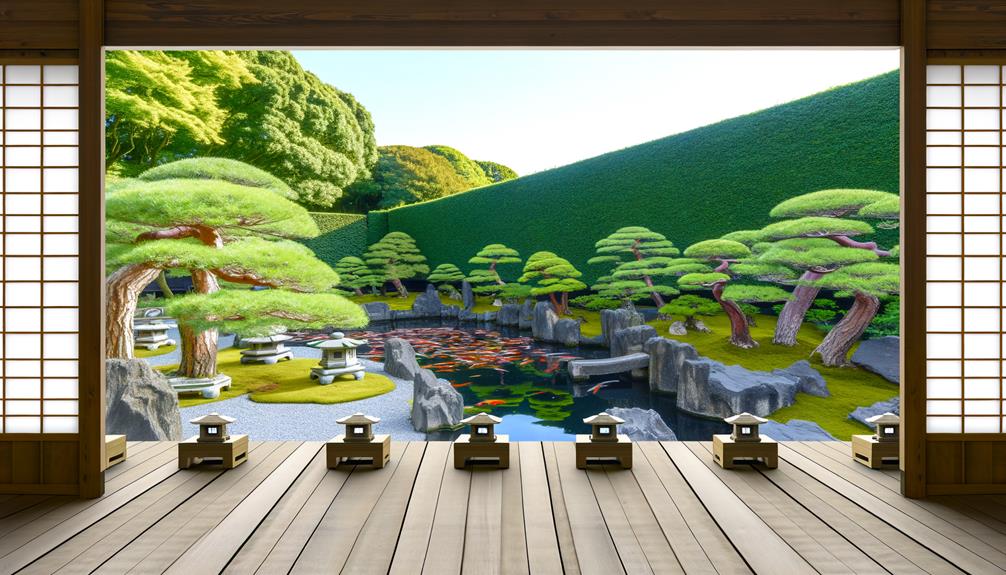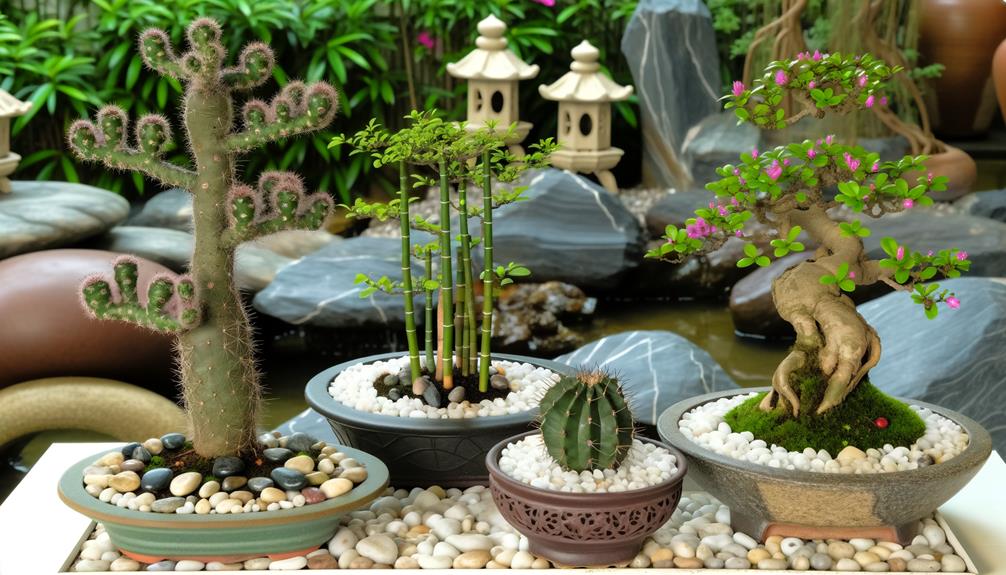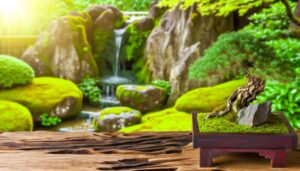Can Anything Be a Bonsai?
While nearly any plant species can be fashioned into a bonsai, certain traits are essential for successful cultivation. Ideal candidates are often those with small leaves, slow growth, and flexible branches.
Traditional species include Japanese Maple, Juniper, and Pine, known for their adaptability and aesthetic appeal. Unconventional choices like succulents, tropical varieties, and flowering plants also make beautiful bonsai.
Key care practices involve meticulous pruning, proper watering, and best soil composition. Although many species can be transformed into bonsai, understanding the nuances of suitable species and care practices is optimal.
Continue exploring to master the intricate art of bonsai cultivation.

Key Takeaways
- Not all plants are suitable for bonsai; selection favors those with small leaves, slow growth, and flexible branches.
- Traditional bonsai species include Japanese Maple, Juniper, Pine, and Ficus, known for their adaptability and aesthetic appeal.
- Tropical plants and flowering species like Bougainvillea and Azalea can also be cultivated as bonsai for year-round growth and seasonal blooms.
- Fruit-bearing plants like apple, lemon, and cherry can be grown as bonsai, adding aesthetic value and edible produce.
- Proper care practices, including precise watering, pruning, and high light intensity, are critical for successfully maintaining any bonsai.
Bonsai Basics

The art of bonsai, rooted in centuries of tradition, encompasses the cultivation and aesthetic shaping of miniature trees within containers. Originating in China and refined by Japanese horticulturists, bonsai is not merely about growing small trees but about replicating the grandeur of nature in a confined space.
Central to this art is the selection of tree species that can thrive under constrained conditions while still mirroring their larger counterparts. Essential elements include soil composition, pot selection, and meticulous pruning techniques. These components ensure the health and longevity of the bonsai, while also contributing to its artistic appeal.
Understanding these basics is vital for anyone wishing to explore the intricate and rewarding practice of bonsai cultivation.
Key Principles
Understanding the key principles of bonsai cultivation is vital for achieving both the aesthetic and horticultural success of these miniature masterpieces. Central to these principles are balance, proportion, and harmony, which guide the shaping and pruning processes.
Balance guarantees the tree appears stable and well-grounded, while proportion maintains the natural scale between the tree and its container. Harmony involves a cohesive relationship between the tree's various elements, fostering a sense of natural beauty.
Equally important is the meticulous care of root systems, which must be pruned to encourage healthy growth within confined spaces. Consistent watering, appropriate soil composition, and regular feeding are also essential to sustain the bonsai's health and vigor, ensuring longevity and beauty.
Suitable Traits

In addition to the key principles of balance, proportion, and harmony, successful bonsai cultivation requires selecting plant species with suitable traits that adapt well to miniaturization. Ideal candidates for bonsai possess characteristics such as small leaves or needles, slow growth rates, and the ability to withstand pruning and shaping.
Moreover, species that exhibit flexible branches and a robust root system are advantageous, as these traits facilitate the necessary manipulation to achieve the desired aesthetic. Resilience to various environmental conditions, including fluctuations in temperature and humidity, also plays an essential role.
Choosing plants with these inherent qualities not only enhances the artistic potential of bonsai but also ensures the longevity and robustness of the miniature trees.
Traditional Species
Traditional bonsai species are often selected for their historical significance and specific horticultural characteristics that make them ideal for bonsai cultivation.
Common bonsai trees, such as Japanese maple (Acer palmatum) and juniper (Juniperus spp.), have been cultivated for centuries due to their adaptability and aesthetic appeal.
Understanding the ideal growing conditions for these species is essential to maintaining their health and achieving the desired artistic form.
Common Bonsai Trees
Among the most revered species in the art of bonsai, the Japanese Maple, Juniper, and Pine trees stand out for their aesthetic appeal and cultural significance. These trees are celebrated for their ability to endure rigorous pruning and training, allowing them to be shaped into stunning miniature forms. Below is a brief overview of these common bonsai species:
| Species | Characteristics |
|---|---|
| Japanese Maple | Deciduous, vibrant autumn colors |
| Juniper | Evergreen, hardy, easy to shape |
| Pine | Evergreen, long needles, aged look |
| Ficus | Tropical, adaptable to indoor growth |
These trees embody the principles of bonsai art, combining natural beauty with meticulous human craftsmanship, making them popular choices among enthusiasts and professionals alike.
Historical Bonsai Species
The rich history of bonsai features a variety of species that have been cultivated and cherished for centuries, reflecting cultural traditions and horticultural expertise.
Among the most iconic are the Japanese Black Pine (Pinus thunbergii), prized for its rugged bark and fine needles, and the Chinese Elm (Ulmus parvifolia), known for its small leaves and graceful form.
The Juniper (Juniperus spp.), with its hardy nature and versatile styling, is another staple. Additionally, the Trident Maple (Acer buergerianum) offers stunning seasonal color changes, while the Satsuki Azalea (Rhododendron indicum) is celebrated for its vibrant blooms.
These traditional species not only embody the aesthetic principles of bonsai but also offer insights into the meticulous care and artistry required.
Ideal Growing Conditions
Optimum growing conditions for traditional bonsai species demand meticulous attention to factors such as light, temperature, humidity, and soil composition. Creating an ideal environment promotes healthy growth and longevity. Traditional species like Junipers, Maples, and Pines have specific needs. For instance, Junipers thrive in bright light, while Maples prefer partial shade. Temperature and humidity levels need to mirror the species' natural habitat. Soil composition is equally essential; it should provide excellent drainage and aeration.
| Species | Light Requirement | Soil Composition |
|---|---|---|
| Juniper | Bright light | Well-draining mixture |
| Maple | Partial shade | Moist but not waterlogged |
| Pine | Full sun | Sandy, well-draining |
Following these conditions guarantees bonsai trees flourish, preserving their small yet impressive presence.
Unconventional Choices

Expanding beyond traditional species, enthusiasts are increasingly experimenting with unconventional plants such as succulents and tropical varieties for bonsai creation. These unexpected choices necessitate innovative techniques to adapt their growth patterns and aesthetics to the bonsai form.
Such creativity not only broadens the scope of bonsai art but also challenges conventional boundaries, offering fresh perspectives on this ancient practice.
Unexpected Bonsai Species
Many enthusiasts are surprised to discover that a diverse range of unconventional species, from flowering shrubs to fruit-bearing trees, can be successfully cultivated as bonsai. For instance, species like the Bougainvillea and Ficus Carica (fig tree) offer unique aesthetic and horticultural qualities.
Bougainvillea, with its vibrant bracts, can provide a striking visual appeal, while Ficus Carica yields small, edible figs, making it both decorative and functional. Similarly, the Pomegranate (Punica granatum) and Olive (Olea europaea) trees are also valued for their ornamental flowers and fruit production.
These unexpected species challenge traditional notions of bonsai, demonstrating that with proper care and technique, a wide array of plant types can be adapted into this ancient art form.
Creative Bonsai Techniques
Building on the surprising versatility of species that can be cultivated as bonsai, employing creative techniques allows enthusiasts to further push the boundaries of this ancient art form. Techniques such as grafting, root-over-rock, and deadwood carving (Jin and Shari) can transform unconventional species into striking bonsai specimens. These methods enhance the aesthetic appeal and cultural significance of the trees, demonstrating the adaptability of bonsai artistry.
| Technique | Description | Example Species |
|---|---|---|
| Grafting | Combining parts from different plants | Fruit Trees |
| Root-over-Rock | Training roots to grow over a rock | Ficus |
| Jin | Creating deadwood on a tree | Juniper |
| Shari | Stripping bark to expose the trunk | Pine |
| Leaf Reduction | Minimizing leaf size through pruning | Maple |
These innovative approaches exemplify how traditional bonsai methods can be adapted for modern artistic expression.
Tropical Plants
Though often linked with temperate species, bonsai cultivation can be effectively applied to a variety of tropical plants, which offer unique aesthetic and horticultural opportunities.
Tropical species such as Ficus, Schefflera, and Bougainvillea are particularly well-suited for bonsai due to their robust growth habits and resilience. These plants thrive in warmer climates and need consistent moisture and light to sustain their health and form.
The use of tropical plants in bonsai allows for vibrant foliage, intriguing trunk structures, and year-round growth, providing enthusiasts with continuous engagement and potential for artistic expression.
Proper care, including suitable watering, fertilization, and pruning, guarantees that these tropical bonsai specimens remain healthy and visually appealing, contributing to the diversity and richness of the bonsai art form.
Flowering Bonsai

Flowering bonsai, known for their exquisite blooms and delicate structures, add an enchanting dimension to the art of bonsai cultivation. These miniature trees, often admired for their seasonal blossoms, require careful care to maintain their beauty and health. The following table provides examples of popular flowering bonsai species, along with their primary blooming season and notable characteristics.
| Species | Blooming Season | Notable Characteristics |
|---|---|---|
| Azalea (Rhododendron) | Spring | Vibrant, profuse blooms |
| Cherry Blossom | Spring | Elegant, delicate flowers |
| Bougainvillea | Summer | Bright, papery bracts |
Cultivating flowering bonsai demands attention to specific light, water, and pruning requirements to ensure ideal flowering and growth. Mastery in these techniques can transform a simple bonsai into a breathtaking floral display.
Fruit-bearing Options
Fruit-bearing bonsai trees, such as apple, lemon, and cherry, offer both aesthetic appeal and the unique satisfaction of cultivating miniature fruits. These varieties require specific care and maintenance practices to guarantee healthy growth and fruit production.
Understanding the nuances of their needs, such as soil composition, watering schedules, and pruning techniques, is essential for successfully nurturing fruit-bearing bonsai.
Popular Fruit Varieties
Among the diverse array of bonsai species, several popular fruit varieties stand out for their unique aesthetic and practical appeal. The miniature versions of fruit-bearing trees such as apple (Malus), fig (Ficus carica), and pomegranate (Punica granatum) not only enhance visual interest with their vibrant fruits but also provide a sense of achievement for the grower.
Citrus varieties, including lemon (Citrus limon) and calamondin (Citrus mitis), are favored for their fragrant blossoms and vividly colored fruit. Additionally, the Japanese quince (Chaenomeles) and cherry (Prunus) species are celebrated for their striking springtime blooms and ornamental fruits.
These fruit-bearing bonsai add a dynamic element to bonsai collections, marrying beauty with the charm of edible produce.
Care and Maintenance
Guaranteeing the health and well-being of fruit-bearing bonsai requires a meticulous approach to watering, pruning, and fertilization. Proper watering is crucial; the soil must remain consistently moist but not waterlogged, as both under and over-watering can stress the plant.
Pruning is crucial not only for maintaining the desired shape but also for promoting healthy growth and fruit production. Regularly remove unwanted branches and thin out dense foliage to enhance light penetration and air circulation.
Fertilization should be tailored to the specific needs of the fruit species, typically involving a balanced, slow-release fertilizer applied during the growing season. Monitoring for pests and diseases is also crucial, as fruit-bearing bonsai can be particularly susceptible.
Proper care guarantees vigorous growth and bountiful fruit yield.
Herbaceous Plants

Herbaceous plants, characterized by their soft, non-woody stems, present unique challenges and opportunities when cultivated as bonsai. Unlike traditional woody species, herbaceous plants require meticulous care to maintain their miniature form, as they are prone to rapid growth and may lack the structural integrity necessary for bonsai aesthetics. Proper pruning and training techniques are essential to shape these plants effectively.
Additionally, herbaceous bonsai often demand more frequent watering and fertilization due to their faster metabolic rates. However, their adaptability and diverse foliage types can result in visually striking bonsai specimens. Successful cultivation hinges on understanding their specific needs and constraints, ensuring a harmonious balance between growth control and plant health.
Succulents and Cacti
Succulents and cacti, with their unique adaptations to arid environments, offer intriguing possibilities for bonsai cultivation. These plants possess distinctive features such as thickened, water-retentive tissues and reduced leaf structures, which make them fascinating subjects for bonsai enthusiasts.
Species like Crassula, Aloe, and various cacti can be trained to mimic the traditional aesthetics of bonsai while retaining their drought-resistant characteristics. The sculptural qualities of succulents and the striking forms of cacti provide a contemporary twist to the ancient art form.
Additionally, their slow growth rates align well with the patience required in bonsai cultivation. By carefully selecting appropriate species, enthusiasts can create visually enchanting bonsai that marry the resilience of desert flora with the elegance of miniature tree artistry.
Care Techniques

Mastering the art of bonsai cultivation, especially with unique species like succulents and cacti, demands a thorough understanding of specific care techniques that cater to their distinct needs.
These plants require a delicate balance of sunlight, watering, and soil composition. Succulents and cacti prefer well-draining soil to prevent root rot, and they need infrequent but deep watering. Positioning them in bright, indirect sunlight guarantees optimal growth without scorching.
Pruning techniques should be gentle, as these species are more delicate compared to traditional bonsai. Additionally, maintaining appropriate humidity levels is essential, as excessive moisture can be harmful.
Fertilization should be minimal, using a balanced, diluted solution to avoid nutrient overload. Proper care ensures these unconventional bonsai thrive beautifully.
Growing Challenges
Cultivating unconventional bonsai species like succulents and cacti presents numerous challenges that require specialized knowledge and techniques. These plants have distinct physiological needs that differ considerably from traditional bonsai trees, demanding an intricate understanding of their water, light, and soil requirements. Proper container selection and drainage become paramount, as cacti and succulents are prone to root rot if overwatered. Additionally, achieving the aesthetic appeal of bonsai while maintaining the health of these species necessitates precise pruning and shaping strategies. Below is a comparison of key challenges:
| Challenge | Description |
|---|---|
| Watering | Requires minimal water; overwatering leads to root rot |
| Soil Composition | Needs well-draining soil to prevent moisture retention |
| Pruning Techniques | Must be done with care to avoid damaging the plant |
| Light Requirements | High light intensity needed; insufficient light can stunt growth |
Understanding these nuances is essential for successful cultivation.
Conclusion
In the enchanting world of bonsai, where miniature trees stand as timeless guardians of nature's grandeur, any plant species, from traditional to unconventional, can be meticulously sculpted into living art.
Whether the subject is a stately juniper or a resilient cactus, the pursuit of bonsai demands unwavering patience, precise care, and an intimate understanding of botanical principles.
This delicate balance between human artistry and natural beauty transforms each bonsai into a tribute to the profound harmony achievable between man and nature.






